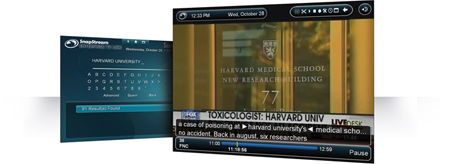

Interview: Jeff Ritter on being a K-12 CIO
Jeff Ritter was kind enough to speak to us about his role as Director of Technology at St. John’s School here in Houston. St. John's School is one of the most respected private schools in the country, currently #22 in the US and #1 in Houston . We're pleased to say they've been a long time customer and supporter of SnapStream.
Q: Tell me about your role as Director of Technology at St. John's School.
Jeff: I function like a corporate CIO. I manage the team that installs, supports, and builds out any technology used by the faculty, students, and staff on campus. We have a Network Administrator that manages the infrastructure, support personnel that support the students and faculty, and a few database people that manage the data. Anything that works on the network and has 1’s and 0’s is usually our baby to take care of.
Q: How does a Director of Technology for a school differ from a corporate CTO?
Jeff: The CTO is very much a true director of technology. The piece that makes this more of a CIO role is that I also manage the curriculum people that manage interfacing with faculty on how to better use the tools available at our disposal, SnapStream being one of those. Once you add in that curricular piece, it becomes more of a job where you’re managing not only technology but also managing information.
“when I bring a tool to the classroom...I try to see the value in it through the faculty lens.”
Q: Does being more of a CIO role change what you look for in a new technology?
Jeff: That’s a good question. A lot of Directors of Technology that have come out of industry don’t have classroom experience so they don’t have a foot to stand on when they try to bring a new technology to the faculty.
I actually came at this from the teaching side and taught for years before I became an administrator. I continue to teach now and when I bring a tool to the classroom or a teacher, usually either I’ve used it in the classroom, or I’ve asked a teacher to use it in their classroom. I try to see the value in it through the faculty lens. Being able to say, “I’ve used this in my classroom, I love it”, “this is what my kids take away from it”, “this is what it has allowed me to do differently”...that really helps.
The people on my staff that work in the curricular side have all been classroom teachers, so that helps us be able to discuss tools with faculty from a point of strength.
Q: Does the training level of the teacher need to be considered when taking on new technologies? Jeff: It’s one of the first hurdles that we go through, looking at a new technology or tool. As all schools do, we’ve got a wide representation of skill sets in our faculty. You may look at a tool that’s fairly complicated but think, “I’ve got 5 teachers that could handle this and it would immediately help them”.
Jeff: It’s one of the first hurdles that we go through, looking at a new technology or tool. As all schools do, we’ve got a wide representation of skill sets in our faculty. You may look at a tool that’s fairly complicated but think, “I’ve got 5 teachers that could handle this and it would immediately help them”.
But if you’re looking for something to roll out across the board, ease of use is one of the first hurdles you look at. You can’t bring something over-complicated nowadays, unless it does something really specific and really awesome.
Q: If ease-of-use is one of the multiple hurdles, what are some of the others?
Jeff: Price. It’s always something that a school is considering. Is it a one-time fee? An on-going cost? Is there a discount for multiple years?
Breadth of use. Is it something specific for physics teachers in 11th grade? Or is it a tool that is going to be used in grade 6th-12th in all disciplines? The wider the breadth the better the tool is. It may be a struggle for those that aren’t classroom teachers, but you have to ask if it’s going to do something that really furthers teaching and learning and removes rote memorization.
Is it something you’re subscribing to outside your district or is it something within the school. If it’s in the school, will it need a dedicated server? How much bandwidth is going to take up?
"The wider the breadth the better the tool is."
Q: How is St. John’s using SnapStream?
Jeff: A lot of the teachers who use it are using it to record certain TV programs that they then want to go back and figure out if there are sections they can use in their classroom to either demonstrate a real world application or use as an authentic voice in a language class.
Are there things that can be grabbed out of a video that can show a student how a topic that you’re going over applies in the real world? Or, is there something historical happening that we’re recording so that we can have record of that and have a debate about it or a discussion?
But the idea is that with SnapStream, you can find clips that are appropriate for your classroom and your kids can watch it before they come to class. Then in class you can then discuss it and have real, meaningful, thought-provoking ways to then discuss that material in class. It goes beyond just what the student may have read for homework.

We’ve had coaches use it, where they record the NCAA soccer championships and have the team watch it. Then they pick it apart to look at formations and when to attack and when not to attack. Video now is all just so easy to get points across, and kids are so visually stimulated that it makes it so easy to use the SnapStream tool to find what you’re looking for and then use it in the classroom, or for homework or whatever.
“...with SnapStream, you have real, meaningful, thought-provoking ways to discuss that material in class. It goes beyond just what the student may have read for homework.”
Q: Do you have any interesting examples of how St. John’s is using SnapStream?
Jeff: Our French teacher tapes the nightly French news because she wants her class to hear authentic voices. So, part of the homework for listening comprehension is to listen to this news program and write about what you got out of it. So, the students are working on not only the listening ear, but the comprehension, and being able to translate that into “this is what I learned”. She has the ability to record these shows and grab the snips that she wants to share, giving the students the chance to hear true, authentic voices.
Our previous American History teachers during the last few elections grabbed the debates and events going on in the news involving the political environment. You can pick your topic and grab news stories as they come up. So that if you wanted to do immigration, abortion or fiscal responsibility, you can grab those clips and then have the students have a debate to discuss what they saw and the factors that go into who our next president may be.
Q: Can you tell me what the process was like for obtaining TV shows or clips before SnapStream?
Jeff: Before, teachers just didn’t really do it. If you knew of the TV clip, you might be able to google it or find it on YouTube. But even then, you’re at the mercy of “did you see it?” and go from there. Before that, some teachers might have been recording on VHS. You also had teachers buying video sets, especially from PBS, where you knew of a show like Cosmos where 3 episodes of season 6 had content you wanted. But you were at the disposal of what you knew of and what you could get your hands on.
With SnapStream, you can record the nightly news and if you know something happened you can then go search for it. If you’re not sure something’s going on, you can pick out words and it’s going to let you know where those words appear in a show and you can go and grab it. It’s made it a lot easier because you have this search capability with TV that you’ve never had before.
"SnapStream has made it a lot easier because you have this search capability with TV that you’ve never had before."
Q: Within the edtech space, are there any trends that you see? Jeff: The collaborative space is big for us right now, and that’s not fancy, but it’s just where we are. Our kids and teachers are wanting to work on things not individually but as groups and even as a teacher/student team. Video is a huge part of that collaboration. Tools like WeVideo, Animoto, and Pixie allow kids to work together on larger projects. There are so many possibilities of how you can cut, slice and dice video to determine what content you want to get out of it.
Jeff: The collaborative space is big for us right now, and that’s not fancy, but it’s just where we are. Our kids and teachers are wanting to work on things not individually but as groups and even as a teacher/student team. Video is a huge part of that collaboration. Tools like WeVideo, Animoto, and Pixie allow kids to work together on larger projects. There are so many possibilities of how you can cut, slice and dice video to determine what content you want to get out of it.
Q: You obviously have a different point of view, having come from the classroom. When looking for new technologies, what advice would you give another Director of Technology that didn’t come out of the classroom?
Jeff: 1. Listen to your faculty. Have a few faculty members from different departments and grade levels that will share what they are seeing. The thing is, our faculty are going out to conferences all over the place and they’re being inundated with tools, so sometimes they come back with great ideas but once we start to scratch the surface we realize we already have something like this.
2. Teacher "brain trust". For someone that isn’t in the classroom, it’s important to have a group of teachers that they can bounce ideas off of, that they can have test a tool. If something like SnapStream comes across your desk, you think “wow, we’re trying to do more video, this might be a great tool”. Having a group of teachers that you can go to who they trust you and you trust them and say, “hey, let's do a webinar on this and test this out, is this something our faculty might like?”.
3. Undersatnd the specific need. As you’re going out to look for tools, try to get a clear idea of what the teacher is trying to accomplish with their classroom and this particular tool. Work with this teacher to investigate the possibilities, because partnering with teachers is going to help you. The Directors of Technology I see that fail are the ones who don’t try to partner with teachers and try to thrust it down someone’s throat or they don’t listen. Having teachers that you can say , “hey, what do you think about this (technology)”, or “what tools are you using now?” “are there things that I can recommend to other teachers?”.
4. Try building a rapport. A reputation as someone that is listening and learning and trying to figure out what teachers need will go a long way.
Want to learn more about how SnapStream can bring TV to the classroom with ease? Contact usto learn more.











